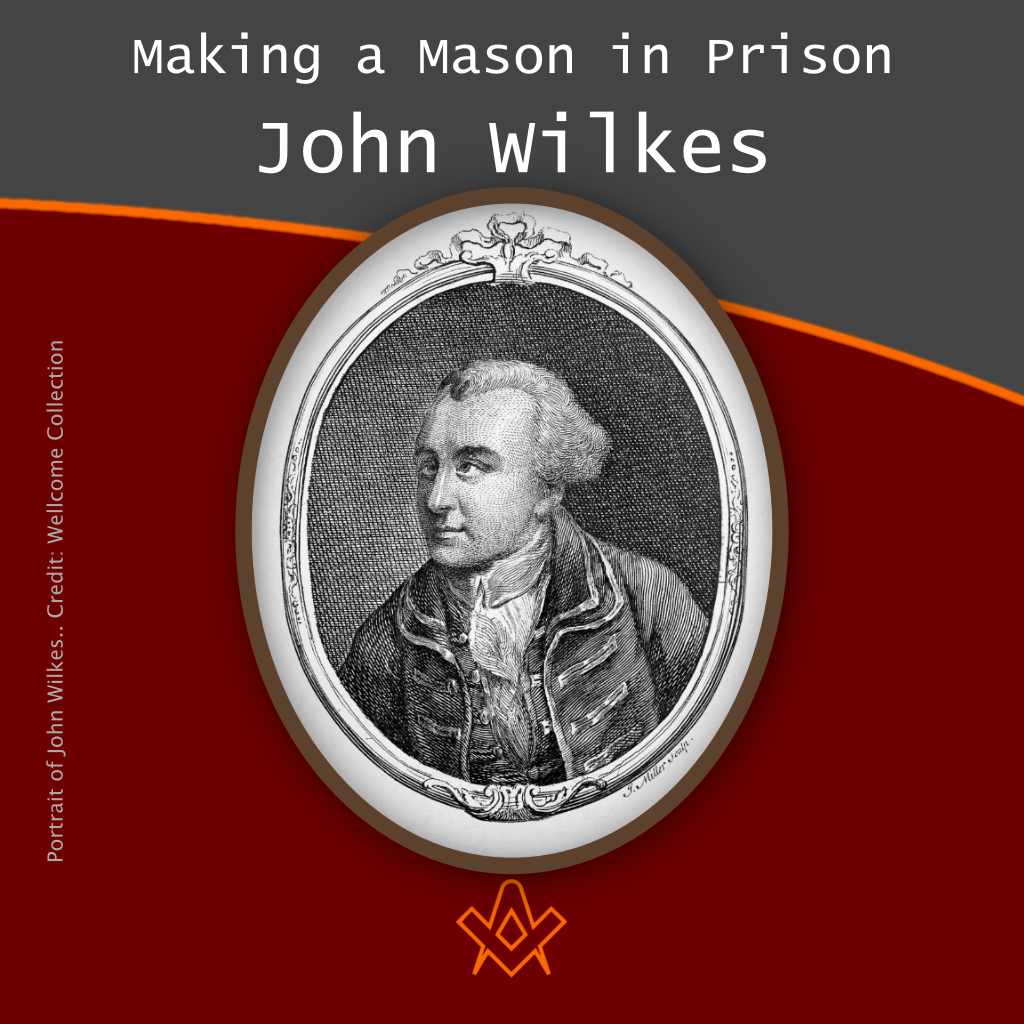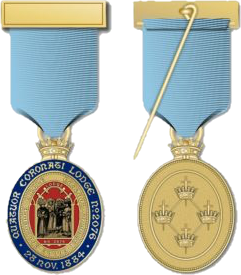We shall be excused by our readers for amusing them with the following anecdote.
All Societies and all Parties were carried away with the ye popular frenzy of ‘Wilkes and Liberty’; and among ye rest, the quiet and peaceable Freemasons came in for their share : —
‘March 3, 1769, ye Members of ye Lodge, held at ye Jerusalem Tavern, in Clerkenwell, attended at the King’s Bench Prison, and made Mr. Wilkes a Mason.’
The Gentleman’s Magazine (a famous newspaper founded in 1731) reported
Video Presentation (English)
text version starts below …

Portrait of John Wilkes
IMAGE LINKED: wellcome collection Attribution 4.0 International (CC BY 4.0)
In Volume 3, Part 1, page 61 of Ars Quatuor Coronatorum we can read that John Wilkes, a journalist and radical politician, was made a Mason on Friday, 3 March 1769. Further, that at his initiation, he was in prison.
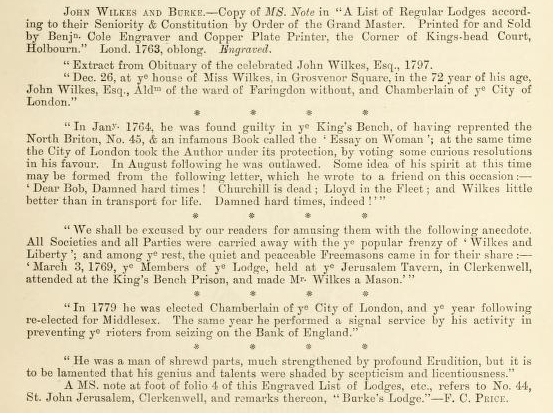
Extract from AQC Vol 3, part I, 1890, p. 61.
IMAGE CREDIT: AQC Attribution
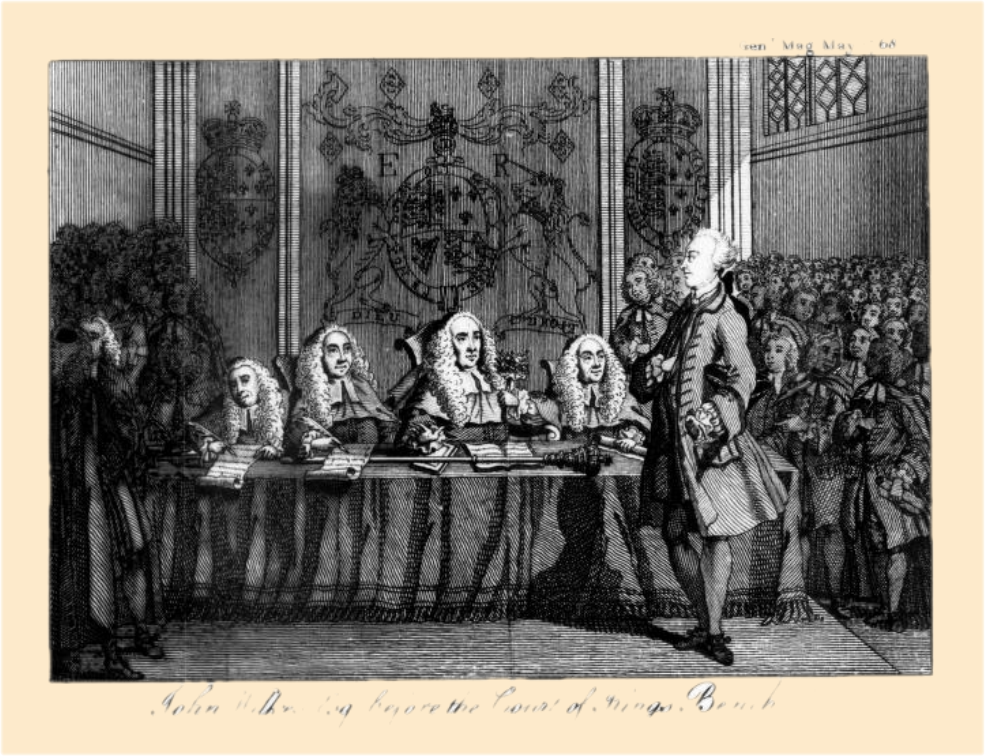
John Wilkes Esq; before the Court of King’s Bench, engraving from The Gentleman’s Magazine for May 1768.
IMAGE LINKED: Archive.org https://archive.org/details/sim_gentlemans-magazine_1768-05_38_5/page/n1/mode/2up
The Jerusalem Tavern
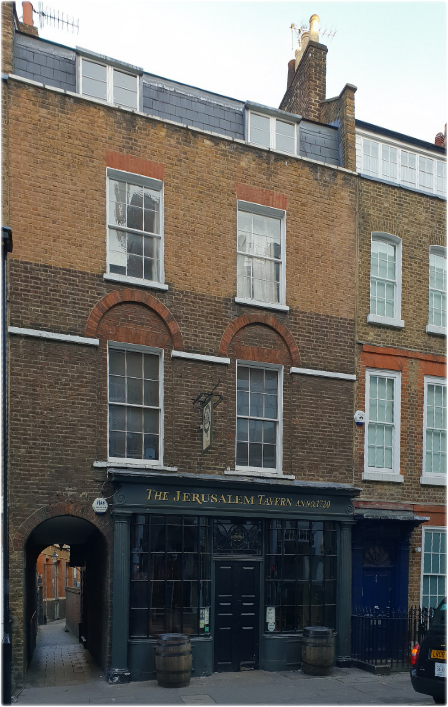
The Jerusalem Tavern (right) and St Johns Path (left) in Britton Street, Clerkenwell, London. By Chris Wood,
IMAGE LINKED: wikimedia Attribution 4.0 International (CC BY 4.0)
So, we know, from this, that John Wilkes was made a Mason by the members of the Jerusalem Tavern’s Lodge in [St John’s Gate] Clerkenwell, London.
But who were they? Lane’s Masonic Records report that the Jerusalem Tavern’s Lodge was a lodge active since 1771.
So were they irregular masons? Probably not, because we know that there was another Jerusalem Lodge which was warranted in 1731, and which changed its meeting place twice as the tavern changed as well.
David Henry was editor of the Gentleman’s Magazine from 1754, after the death of Edward Cave (or Sylvanus Urban as he signed himself).
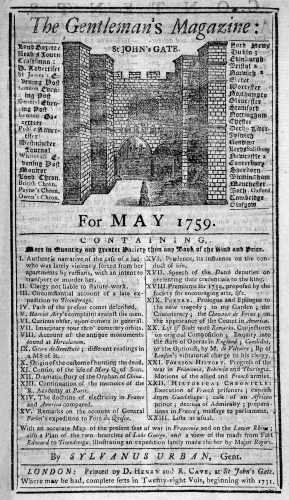
Front page of The Gentleman’s Magazine, London, May 1759.
IMAGE LINKED: wikimedia Attribution 4.0 International (CC BY 4.0)
The magazine was in fact written and printed in the Jerusalem Tavern itself at St John’s Gate.
So, we might be forgiven for assuming that the author’s sources must have been accurate.
In 1762, David Henry married the widow of Mr. Newell, formerly the master of the Jerusalem Tavern. So he also owned the tavern where the lodge met.
John Wilkes (17th October 1725 – 26 December 1797), was the son of Israel Wilkes, a malt distiller. He was a journalist and a radical politician.
The AQC paper reports;
“He was a man of shrewd parts, much strengthened by profound Erudition, but it is to be lamented that his genius and talents were shaded by scepticism and licentiousness.”
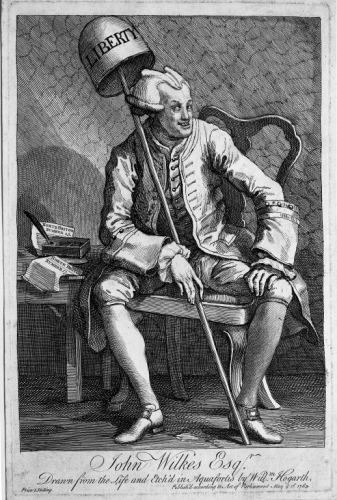
John Wilkes, Esq., 1763. Etching by William Hogarth (British, 1697-1764), Brooklyn Museum, bequest of Samuel E. Haslett.
IMAGE LINKED: Brooklyn Museum Attribution 4.0 International (CC BY 4.0)
Elected Member of Parliament for Aylesbury in 1757, he created in 1762, a weekly newspaper: The North Briton, which attacked George III and John Stuart, 3rd Earl of Bute who was then the Prime Minister.

King George III. Stipple engraving by P.W. Tomkins, 1801..
IMAGE LINKED: wellcome collection Attribution 4.0 International (CC BY 4.0)

John Stuart, 3rd Earl of Bute depicted as a Colossus wearing a tartan scarf about his shoulders stands on two stone pedestals before the tower to St James’s Palace as William Pitt the Elder, leaning on a crutch, pleads with him from below. Engraving, 1767..
IMAGE LINKED: wellcome collection Attribution 4.0 International (CC BY 4.0)
Wilkes was angry with what he felt were too generous peace terms given to France at the end of the Seven Years’ War.
Great Britain had gained the bulk of New France in North America, Spanish Florida, some Caribbean islands in the West Indies, the colony of Senegal and superiority over the French trading outposts on the Indian subcontinent.
For Wilkes this was still not enough. Even more, Wilkes hated his Prime Minister most for being a Scot!
The name of his newspaper The North Briton was chosen in response to The Briton (a pro-government newspaper published by Tobias Smollet) Wilkes issued his paper only a week after Smollet’s publication.
It was an anonymous paper, but everyone knew that Wilkes was behind it.
So when in the issue number 45 (a symbolic number for the Jacobite movement) The North Briton attacked a royal speech of George III praising the Treaty of Paris, Wilkes and forty eight other people were arrested for seditious libel.
When you read the article, you understand why!
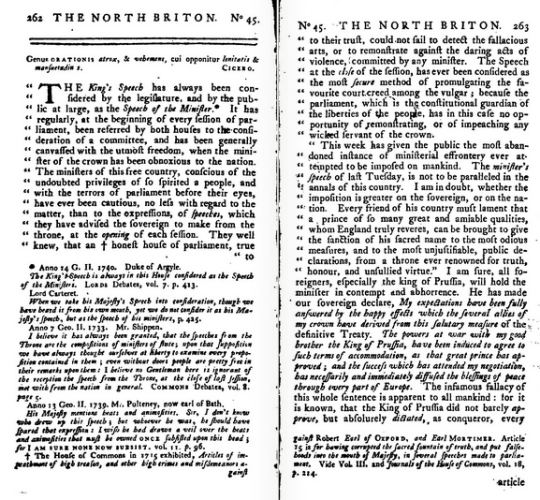
Extract of the North Briton Number 45.
IMAGE LINKED: wikimedia Attribution 4.0 International (CC BY 4.0)
As a Member of Parliament he was protected by his status and was quickly released.
However, Parliament voted that his privilege from arrest did not extend to the writing and publishing of seditious libels.
Wilkes wisely moved to Paris and didn’t return until 1768.
Re-elected as a Parliament Member he was then arrested and detained at King’s Bench prison. An event which led to the Massacre of St George’s Field on 10 May 1768, where a crowd of 15,000 citizens came to riot (or support) Wilkes and were hunted down by the troops.
Seven people were killed, including one young man, William Allen, mistaken for a rioter. The Irish playwright and government supporter Hugh Kelly made a defence of the government’s right to use force against Wilkes’ supporters.
This in turn led to a riot at the production of Kelly’s new play A Word to the Wise at the Drury Lane Theatre, forcing the production to be abandoned.

St George’s Fields, Southwark: anti-Catholic rioters in the Gordon riots wielding sticks, displaying banners, and setting buildings on fire. Etching, 1780
IMAGE LINKED: wellcome collection Attribution 4.0 International (CC BY 4.0)
On 8 June, Wilkes received a twenty-two month sentence for blasphemy and seditious libel, and was expelled from the House of Commons. Naturally, some of his friends tried to help him in many ways – including bringing him into Freemasonry under a dispensation from the Grand Master:
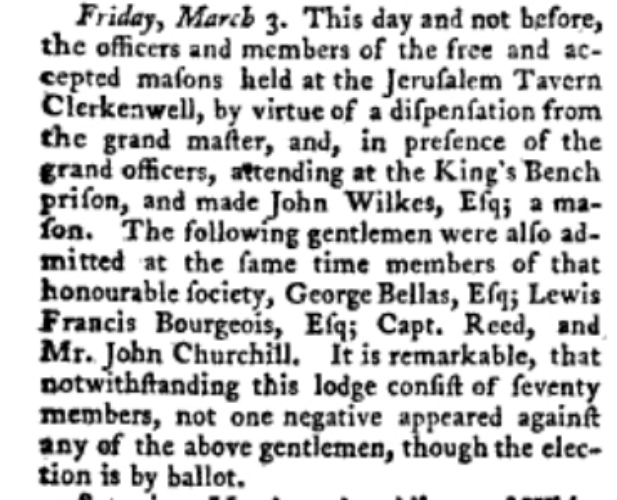
Extract – The Oxford Magazine Or Universal Museum, Volume 2, for March 1769
IMAGE LINKED: Wikimedia Attribution 4.0 International (CC BY 4.0)
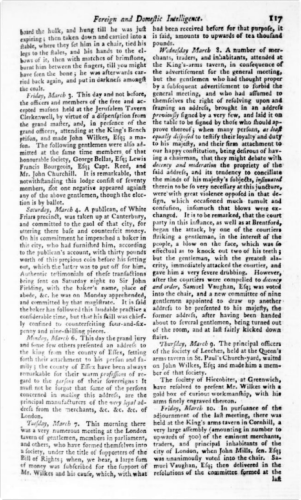
Full page of the Oxford Magazine Or Universal Museum, Volume 2, for March 1769
IMAGE LINKED: Wikimedia Attribution 4.0 International (CC BY 4.0)
He was initiated with others such as George Bellas, Lewis Francis Bourgeois, Capt. Reed, and John Churchill.
But, how could an initiation ceremony have been performed in a prison? Part of the answer was given by J. M. Hamill to Cecile Révauger in their correspondence where he said:
Denslow, in his 10000 Famous Freemasons, is correct in stating that John Wilkes was initiated by members of the Jerusalem Lodge n°44. What is problematical is whether the event took place in prison or whether John Wilkes was allowed out on parole for the event, as was possible as he was in a debtor’s prison . The press reports of his initiation state that it took place in the prison but this was later denied by the Masonic authorities as holding a meeting in prison was contrary to Masonic rules. The Minute Book of Jerusalem Lodge unfortunately does not state where the meeting took place.
But the legend has remained and some other papers like the Lloyds Evening Post continued this story.
Lloyd’s Evening Post, also known as Lloyd’s Evening Post and British Chronicle, was a British evening newspaper published tri-weekly in London from 1757 to 1808.
Founded shortly after the London Chronicle and similar in format, it came out on Monday, Wednesday and Friday, alternating in “friendly rivalry” with the London Chronicle which came out on Tuesday, Thursday, and Saturday.

Lloyd’s Evening Post
IMAGE LINKED: Wikimedia Attribution 4.0 International (CC BY 4.0)
It is though proper to acquaint the Public, that I, in the presence of two grand Officers, and by virtue of a general Dispensation, dated February 2, 1769, signed by the Deputy Grand Master, did make Mr. Wilkes a Free and Accepted Mason. The Dispensation may be seen by any Mason, at the Jerusalem Lodge, No. 44, on a Lodge night.
– Tho. DOSSON, Master.
George Bellas and John Churchill who were also initiated that night were members of a society created only a few days before their initiations: the Society of the Gentleman Supporters of the Bill of Rights, founded on 20 February 1769, and consisting of many Freemasons.
Created three days after the eviction of Wilkes from his new Parliament seat in February, it was;
“primarily to support the political career of John Wilkes, the leadership of the Society, and most notably Rev. John Horn Tooke, subsequently took steps to broaden its aims to include a full program of radical reforms”.
It is certain that the Wilkes’ initiation was a political matter between engaged Masons who were in the public life of London.
However, it raises the question as to whether Wilkes fulfilled the requirement in his obligation to be free and of good report.
Andersen’s Constitutions noted:
“The Persons admitted Members of a Lodge must be good and true Men, free-born, and of mature and discreet Age, no Bondmen, no Women, no immoral of scandalous Men, but of good Report.”
For his supporters, John Wilkes was a man of good report, good and true (member of so many clubs that no one knows the list by heart), free-born, of mature and discreet age, not a Bondman, or a woman.
The only thing which could have stopped him was that he was an immoral and scandalous man, but apparently, that didn’t matter.
Was his initiation a mistake?
The Freemasons Magazine and Masonic Mirror from 27 October 1860 noted:
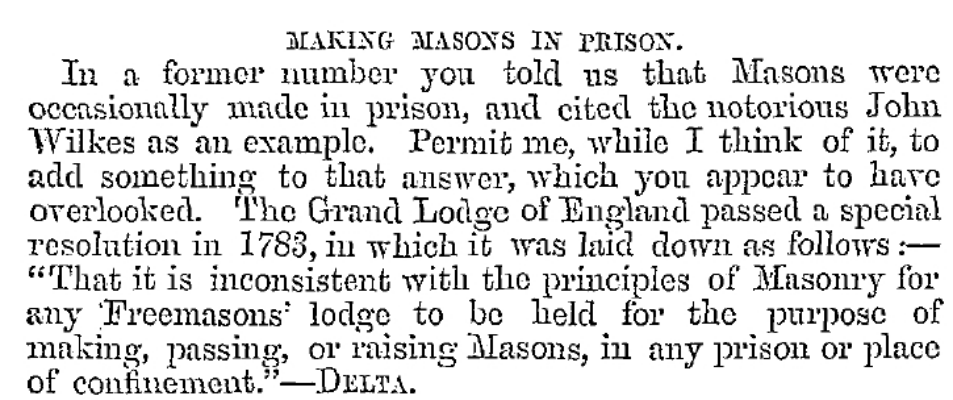
Freemasons Magazine and Masonic Mirror, 27 October 1860.
IMAGE LINKED: Wikimedia Attribution 4.0 International (CC BY 4.0)
And so the story continues to join other stories in Freemasonry which are difficult to prove due to conflicting evidence – or, sometimes, no evidence at all.
The name of John Wilkes has become synonymous, however, with political dissent.
John Wilkes was 32 years old when his newspaper began its attacks on the establishment.
Only five years after this article in the Freemason’s Magazine a twenty-seven year old John Wilkes Booth named after John Wilkes would murder Abraham Lincoln because of political dissent.
John Wilkes Booth was also reputed to be a 33rd degree Freemason, while Lincoln himself had petitioned to join the Order after his term in office.
In later life John Wilkes became less radical, becoming Lord Mayor of London, Master of the Worshipful Company of Joiners and Ceilers of the City of London, and a magistrate who defended the Bank of England with troops.
He died in his bed in his house in Grosvenor Square, London, at the age of seventy two.
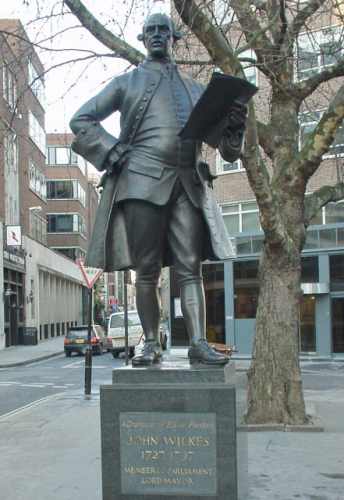
Statue of John Wilkes in Fetter Lane, London.
IMAGE LINKED: Wikimedia Attribution 4.0 International (CC BY 4.0)
Article by: Hervé H. Lecoq

Hervé H. Lecoq (P.M., M.M.M., M.C., M.R., S.E.M., E.M., C.A.R.) born in 1982 and works as a manager in the field of online sales.
Member of the Académie de Vaucluse and of various historical associations, having received the Light in 2009, since 2010, he has administered various websites relating to Freemasonry.
Authors of articles in French but also English in journals, magazines or on news sites, he is the author of the Masonic science-fiction novel: L'Apprenti Perdu (ECE-D editions) and administers the Youtube channel: French Freemason.
Masonic web site: https://hervehlecoq.way.live/
Youtube Channel: https://www.youtube.com


Style Emulation: Apprenti, Compagnon, Jeune Maître (Mes premières questions sur la Franc-Maçonnerie) (French Edition)
By: Hervé H. Lecoq (Author)
There are very few books in French on the English Emulation style rite to learn about each grade and improve.
This book was thus born from a request from Apprentices, Companions and Young Masters who wanted a guide, in French, to enable them to understand the logic of the teachings of this rite, its History and its customs.
Validated and improved in the Lodge for several years by “masonic students”, you will appreciate being taken by the hand, throughout your progression up to the rank of Master, by advice to improve your practice, clarity of explanations history and the benevolence of this Mentor to take with you everywhere.
Recent Articles: in people series
 Celebrate the extraordinary legacy of The Marquis de La Fayette with C.F. William Maurer's insightful exploration of Lafayette's 1824-25 tour of America. Discover how this revered leader and Freemason was honored by a young nation eager to showcase its growth and pay tribute to a hero of the American Revolution. |
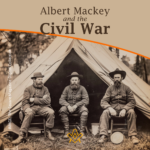 Albert Mackey and the Civil War In the midst of the Civil War's darkness, Dr. Albert G. Mackey, a devoted Freemason, shone a light of brotherhood and peace. Despite the nation's divide, Mackey tirelessly advocated for unity and compassion, embodying Freemasonry's highest ideals—fraternal love and mutual aid. His actions remind us that even in dire times, humanity's best qualities can prevail. |
 Discover the enduring bond of brotherhood at Lodge Dumfries Kilwinning No. 53, Scotland's oldest Masonic lodge with rich historical roots and cultural ties to poet Robert Burns. Experience rituals steeped in tradition, fostering unity and shared values, proving Freemasonry's timeless relevance in bridging cultural and global divides. Embrace the spirit of universal fraternity. |
 Discover the profound connections between John Ruskin's architectural philosophies and Freemasonry's symbolic principles. Delve into a world where craftsmanship, morality, and beauty intertwine, revealing timeless values that transcend individual ideas. Explore how these parallels enrich our understanding of cultural history, urging us to appreciate the deep impacts of architectural symbolism on society’s moral fabric. |
 Discover the incredible tale of the Taxil Hoax: a stunning testament to human gullibility. Unmasked by its mastermind, Leo Taxil, this elaborate scheme shook the world by fusing Freemasonry with diabolical plots, all crafted from lies. Dive into a story of deception that highlights our capacity for belief and the astonishing extents of our credulity. A reminder – question everything. |
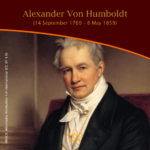 Dive into the extraordinary legacy of Alexander Von Humboldt, an intrepid explorer who defied boundaries to quench his insatiable thirst for knowledge. Embarking on a perilous five-year journey, Humboldt unveiled the Earth’s secrets, laying the foundation for modern conservationism. Discover his timeless impact on science and the spirit of exploration. |
 Voltaire - Freethinker and Freemason Discover the intriguing connection between the Enlightenment genius, Voltaire, and his association with Freemasonry in his final days. Unveil how his initiation into this secretive organization aligned with his lifelong pursuit of knowledge, civil liberties, and societal progress. Explore a captivating facet of Voltaire's remarkable legacy. |
 Robert Burns; But not as we know him A controversial subject but one that needs addressing. Robert Burns has not only been tarred with the presentism brush of being associated with slavery, but more scaldingly accused of being a rapist - a 'Weinstein sex pest' of his age. |
 Richard Parsons, 1st Earl of Rosse Discover the captivating story of Richard Parsons, 1st Earl of Rosse, the First Grand Master of Grand Lodge of Ireland, as we explore his rise to nobility, scandalous affiliations, and lasting legacy in 18th-century Irish history. Uncover the hidden secrets of this influential figure and delve into his intriguing associations and personal life. |
 James Gibbs St. Mary-Le-Strand Church Ricky Pound examines the mysterious carvings etched into the wall at St Mary-Le-Strand Church in the heart of London - are they just stonemasons' marks or a Freemason’s legacy? |
 Freemasonry and the Royal Family In the annals of British history, Freemasonry occupies a distinctive place. This centuries-old society, cloaked in symbolism and known for its masonic rituals, has intertwined with the British Royal Family in fascinating ways. The relationship between Freemasonry and the Royal Family is as complex as it is enduring, a melding of tradition, power, and mystery that continues to captivate the public imagination. |
 A Man Of High Ideals: Kenneth Wilson MA A biography of Kenneth Wilson, his life at Wellington College, and freemasonry in New Zealand by W. Bro Geoff Davies PGD and Rhys Davies |
 In 1786, intending to emigrate to Jamaica, Robert Burns wrote one of his finest poetical pieces – a poignant Farewell to Freemasonry that he wrote for his Brethren of St. James's Lodge, Tarbolton. |
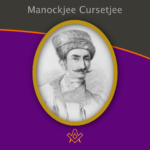 Alex Lishanin explores Mumbai and discovers the story of Lodge Rising Star of Western India and Manockjee Cursetjee – the first Indian to enter the Masonic Brotherhood of India. |
 Aleister Crowley - a very irregular Freemason Aleister Crowley, although made a Freemason in France, held a desire to be recognised as a 'regular' Freemason within the jurisdiction of UGLE – a goal that was never achieved. |
 Sir Joseph Banks – The botanical Freemason Banks was also the first Freemason to set foot in Australia, who was at the time, on a combined Royal Navy & Royal Society scientific expedition to the South Pacific Ocean on HMS Endeavour led by Captain James Cook. |
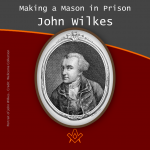 Making a Mason in Prison: the John Wilkes’ exception? |
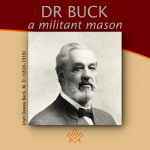 "To be a good man and true" is the first great lesson a man should learn, and over 40 years of being just that in example, Dr Buck won the right to lay down the precept. |
 Elias Ashmole: Masonic Hero or Scheming Chancer? The debate is on! Two eminent Masonic scholars go head to head: Yasha Beresiner proposes that Elias Ashmole was 'a Masonic hero', whereas Robert Lomas posits that Ashmole was a 'scheming chancer'. |
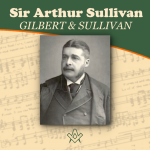 Sir Arthur Sullivan - A Masonic Composer We are all familiar with the comic operas of Gilbert and Sullivan, but did you know Sullivan was a Freemason, lets find out more…. |
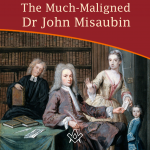 The Much-Maligned Dr John Misaubin The reputation of the Huguenot Freemason, has been buffeted by waves of criticism for the best part of three hundred years. |
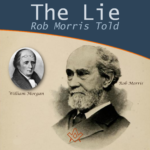 Was William Morgan really murdered by Masons in 1826? And what was the lie Masonic author Rob Morris told? Find out more in the intriguing story of 'The Morgan Affair'. |
 Lived Respected - Died Regretted Lived Respected - Died Regretted: a tribute to HRH The Prince Philip, Duke of Edinburgh |
 Who was Moses Jacob Ezekiel, a Freemason, American Civil War Soldier, renowned sculptor ? |
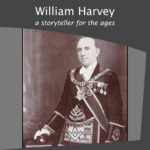 A Masonic author and Provincial Grand Master of Forfarshire in Scotland |
 Who was Philip, Duke of Wharton and was he Freemasonry’s Loose Cannon Ball ? |
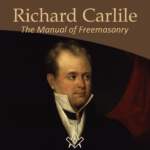 Richard Carlile - The Manual of Freemasonry Will the real author behind The Manual of Freemasonry please stand up! |
 Nicholas Hawksmoor – the ‘Devil’s Architect’ Nicholas Hawksmoor was one of the 18th century’s most prolific architects |
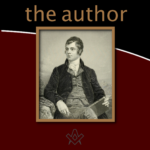 By Bro. Anthony Oneal Haye (1838-1877), Past Poet Laureate, Lodge Canongate Kilwinning No. 2, Edinburgh. |
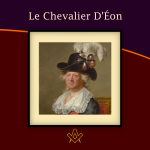 The Curious Case of the Chevalier d’Éon A cross-dressing author, diplomat, soldier and spy, the Le Chevalier D'Éon, a man who passed as a woman, became a legend in his own lifetime. |
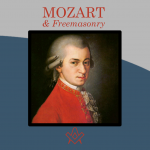 Mozart Freemasonry and The Magic Flute. Rev'd Dr Peter Mullen provides a historical view on the interesting topics |
masonic knowledge
to be a better citizen of the world
share the square with two brothers

click image to open email app on mobile device
